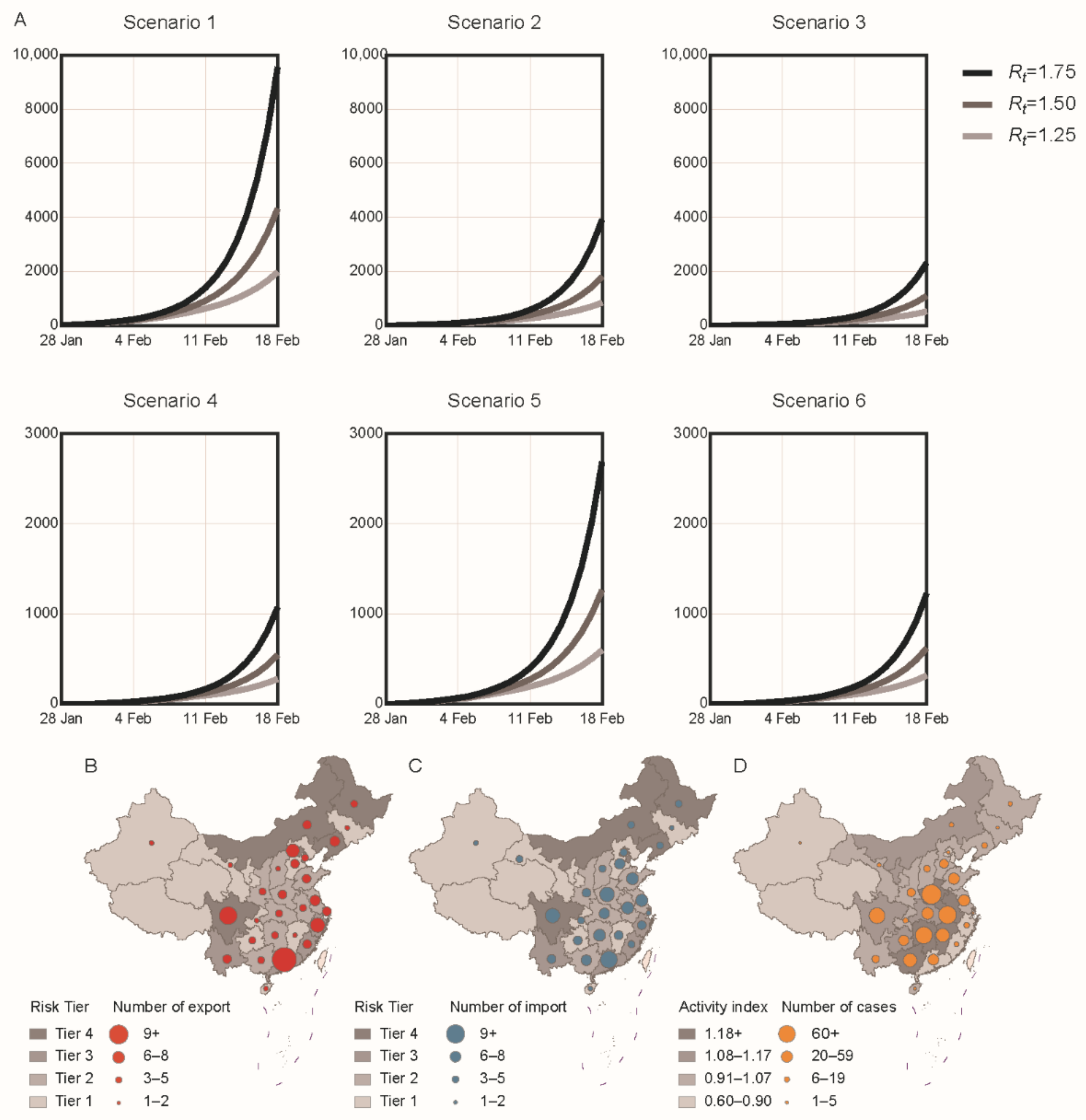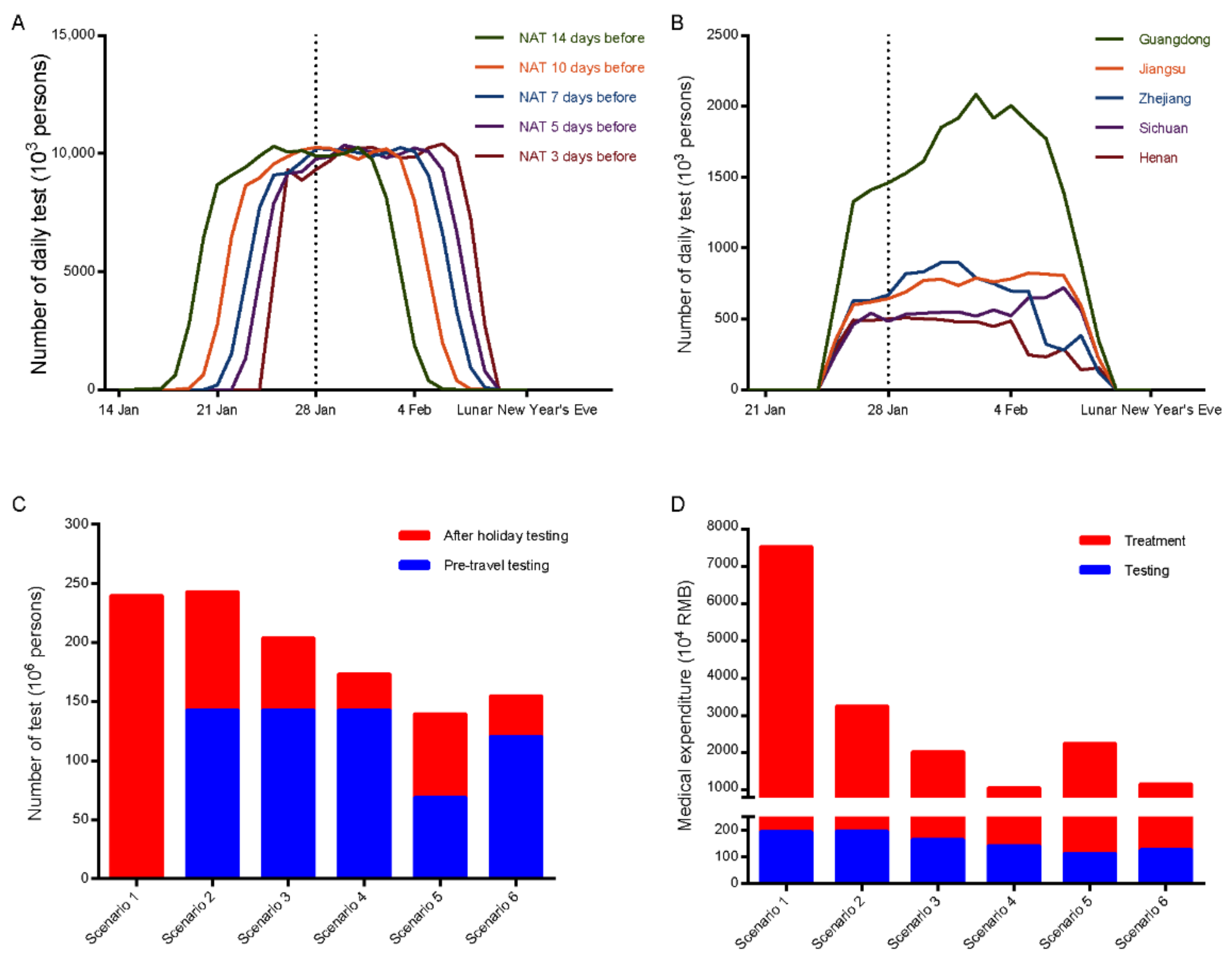An Optimal Nucleic Acid Testing Strategy for COVID-19 during the Spring Festival Travel Rush in Mainland China: A Modelling Study
Abstract
1. Introduction
2. Materials and Methods
2.1. Simulation of the Populations
2.2. Simulation of Testing Strategies
2.3. Simulation of Local Transmission during the Spring Festival Period
3. Results
3.1. Simulated Populations
3.2. Effectiveness of Testing Strategies
3.3. Local Transmission during the Spring Festival Period
3.4. Nucleic Acid Testing (NAT) Burden and Medical Expenditure
4. Discussion
5. Conclusions
Supplementary Materials
Author Contributions
Funding
Institutional Review Board Statement
Informed Consent Statement
Data Availability Statement
Acknowledgments
Conflicts of Interest
References
- Zhu, N.; Zhang, D.; Wang, W.; Li, X.; Yang, B.; Song, J.; Zhao, X.; Huang, B.; Shi, W.; Lu, R.; et al. A Novel Coronavirus from Patients with Pneumonia in China, 2019. N. Engl. J. Med. 2020, 382, 727–733. [Google Scholar] [CrossRef] [PubMed]
- Chinazzi, M.; Davis, J.T.; Ajelli, M.; Gioannini, C.; Litvinova, M.; Merler, S.; Piontti, Y.; Pastore, A.; Mu, K.; Rossi, L.; et al. The Effect of Travel Restrictions on the Spread of the 2019 Novel Coronavirus (Covid-19) Outbreak. Science 2000, 368, 395–400. [Google Scholar] [CrossRef] [PubMed]
- FlightAware—Flight Tracker/Flight Status. Available online: https://uk.flightaware.com (accessed on 3 February 2021).
- World Health Organization. Weekly Epidemiological Update—29 December 2020; WHO: Geneva, Switzerland, 2020. [Google Scholar]
- TSA Checkpoint Travel Numbers (Current Year(s) Versus Prior Year/Same Weekday). Available online: https://www.tsa.gov/coronavirus/passenger-throughput (accessed on 3 February 2021).
- World Health Organization. Report of the Who-China Joint Mission on Covid-19; WHO: Geneva, Switzerland, 2020. [Google Scholar]
- National Health Commission of the People’s Republic of China—COVID-19 Epidemic Prevention and Control—Epidemic Notification. Available online: http://www.nhc.gov.cn/xcs/yqtb/list_gzbd.shtml (accessed on 3 February 2021). (In Chinese)
- Chen, J.; Feng, Z.-H.; Ye, L.; Cheng, Y.-R.; Zhou, M.-Y.; Li, Y.; Du, C.; Wang, L.; Wang, M.-W. Travel rush during Chinese Spring Festival and the 2019-nCoV. Travel Med. Infect. Dis. 2020, 37, 101686. [Google Scholar] [CrossRef] [PubMed]
- Zhang, Y. A Total of 143 Million Trips Made Before the 2019 Spring Festival Travel Rush. People’s Railway Daily, 11 February 2019, A1. Available online: http://www.peoplerail.com/rmtd2016/content/2019-02/11/content_69405.htm (accessed on 12 February 2021). (In Chinese).
- Chin, E.T.; Lo, N.C.; Huynh, B.Q.; Murrill, M.; Basu, S. Frequency of Routine Testing for Sars-Cov-2 to Reduce Transmission among Workers. medRxiv 2020. [Google Scholar] [CrossRef]
- He, X.; Lau, E.H.Y.; Wu, P.; Deng, X.; Wang, J.; Hao, X.; Lau, Y.C.; Wong, J.Y.; Guan, Y.; Tan, X.; et al. Temporal Dynamics in Viral Shedding and Transmissibility of Covid-19. Nat. Med. 2020, 26, 672–675. [Google Scholar] [CrossRef] [PubMed]
- Ma, S.; Zhang, J.; Zeng, M.; Yun, Q.; Guo, W.; Zheng, Y.; Zhao, S.; Wang, M.H.; Yang, Z. Epidemiological Parameters of COVID-19: Case Series Study. J. Med. Internet Res. 2020, 22, e19994. [Google Scholar] [CrossRef] [PubMed]
- Oran, D.P.; Topol, E.J. Prevalence of Asymptomatic Sars-Cov-2 Infection: A Narrative Review. Ann. Intern. Med. 2020, 173, 362–367. [Google Scholar] [CrossRef] [PubMed]
- Li, R.; Pei, S.; Chen, B.; Song, Y.; Zhang, T.; Yang, W.; Shaman, J. Substantial Undocumented Infection Facilitates the Rapid Dissemination of Novel Coronavirus (Sars-Cov-2). Science 2020, 368, 489–493. [Google Scholar] [CrossRef] [PubMed]
- Sun, K.; Wang, W.; Gao, L.; Wang, Y.; Luo, K.; Ren, L.; Zhan, Z.; Chen, X.; Zhao, S.; Huang, Y.; et al. Transmission Heterogeneities, Kinetics, and Controllability of Sars-Cov-2. Science 2020, 371. [Google Scholar] [CrossRef]
- Kucirka, L.M.; Lauer, S.A.; Laeyendecker, O.; Boon, D.; Lessler, J. Variation in False-Negative Rate of Reverse Transcriptase Polymerase Chain Reaction-Based Sars-Cov-2 Tests by Time since Exposure. Ann. Intern. Med. 2020, 173, 262–267. [Google Scholar] [CrossRef] [PubMed]
- Wei, J.T.; Liu, Y.X.; Zhu, Y.C.; Qian, J.; Ye, R.Z.; Li, C.Y.; Ji, X.K.; Li, H.K.; Qi, C.; Wang, Y.; et al. Impacts of transportation and meteorological factors on the transmission of COVID-19. Int. J. Hyg. Environ. Health 2020, 230, 113610. [Google Scholar] [CrossRef] [PubMed]
- Barbieri, D.M.; Lou, B.; Passavanti, M.; Hui, C.; Hoff, I.; Lessa, D.A.; Sikka, G.; Chang, K.; Gupta, A.; Fang, K.; et al. Impact of COVID-19 pandemic on mobility in ten countries and associated perceived risk for all transport modes. PLoS ONE 2021, 16, e0245886. [Google Scholar] [CrossRef] [PubMed]
- Jia, X.; Chen, J.; Li, L.; Jia, N.; Jiangtulu, B.; Xue, T.; Zhang, L.; Li, Z.; Ye, R.; Wang, B. Modeling the Prevalence of Asymptomatic Covid-19 Infections in the Chinese Mainland. Innovation 2020, 1, 100026. [Google Scholar] [CrossRef] [PubMed]
- Baidu Migration. Available online: https://qianxi.baidu.com/2020 (accessed on 3 February 2021). (In Chinese).
- China Daily—Expanded COVID-19 Testing to Cover Key Groups. Available online: https://epaper.chinadaily.com.cn/a/202006/09/WS5edebf27a3107831ec75297b.html (accessed on 3 February 2021).
- Gibbs, H.; Liu, Y.; Pearson, C.A.; Jarvis, C.I.; Grundy, C.; Quilty, B.J.; Diamond, C.; Eggo, R.M. Changing Travel Patterns in China During the Early Stages of the Covid-19 Pandemic. Nat. Commun. 2020, 11, 5012. [Google Scholar] [CrossRef] [PubMed]
- Ministry of Transport of the People’s Republic of China—Statistical Data. Available online: http://www.mot.gov.cn/tongjishuju (accessed on 3 February 2021). (In Chinese)
- Lewnard, J.A.; Lo, N.C. Scientific and Ethical Basis for Social-Distancing Interventions against Covid-19. Lancet Infect. Dis. 2020, 20, 631–633. [Google Scholar] [CrossRef]



| Parameters | Value | Range | References |
|---|---|---|---|
| Population size | 10,000,000 | ||
| Incubation period | 6 days | 1–17 days | [11,12] |
| Infectious period | 5 days | [11] | |
| Proportion of asymptomatic cases | 50% | 30–70% | [13,14] |
| Proportion of transmission during pre-symptomatic period | 50% | [15] | |
| Daily SARS-CoV-2 infection incidence | 1 to 100 infections per 10,000,000 | ||
| Relative risk of COVID-19 infection during day of travel | 2 | 1–10 | [17,18] |
| PCR sensitivity | 80–95% | [16] | |
| PCR specificity | 99.8% | 99.5–100% | [16] |
| Compliance with testing | 100% | ||
| Effective reproduction number | 1.25–1.75 |
Publisher’s Note: MDPI stays neutral with regard to jurisdictional claims in published maps and institutional affiliations. |
© 2021 by the authors. Licensee MDPI, Basel, Switzerland. This article is an open access article distributed under the terms and conditions of the Creative Commons Attribution (CC BY) license (http://creativecommons.org/licenses/by/4.0/).
Share and Cite
Zhou, Y.-H.; Ma, K.; Xiao, P.; Ye, R.-Z.; Zhao, L.; Cui, X.-M.; Cao, W.-C. An Optimal Nucleic Acid Testing Strategy for COVID-19 during the Spring Festival Travel Rush in Mainland China: A Modelling Study. Int. J. Environ. Res. Public Health 2021, 18, 1788. https://doi.org/10.3390/ijerph18041788
Zhou Y-H, Ma K, Xiao P, Ye R-Z, Zhao L, Cui X-M, Cao W-C. An Optimal Nucleic Acid Testing Strategy for COVID-19 during the Spring Festival Travel Rush in Mainland China: A Modelling Study. International Journal of Environmental Research and Public Health. 2021; 18(4):1788. https://doi.org/10.3390/ijerph18041788
Chicago/Turabian StyleZhou, Yu-Hao, Ke Ma, Peng Xiao, Run-Ze Ye, Lin Zhao, Xiao-Ming Cui, and Wu-Chun Cao. 2021. "An Optimal Nucleic Acid Testing Strategy for COVID-19 during the Spring Festival Travel Rush in Mainland China: A Modelling Study" International Journal of Environmental Research and Public Health 18, no. 4: 1788. https://doi.org/10.3390/ijerph18041788
APA StyleZhou, Y.-H., Ma, K., Xiao, P., Ye, R.-Z., Zhao, L., Cui, X.-M., & Cao, W.-C. (2021). An Optimal Nucleic Acid Testing Strategy for COVID-19 during the Spring Festival Travel Rush in Mainland China: A Modelling Study. International Journal of Environmental Research and Public Health, 18(4), 1788. https://doi.org/10.3390/ijerph18041788







